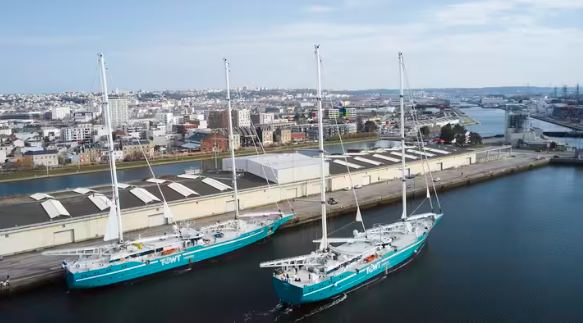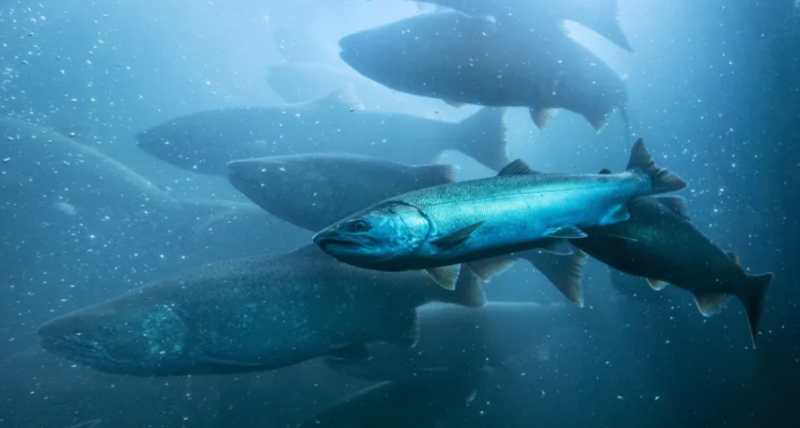As part of the « Projet Océan », franceinfo met with those in France working to decarbonize the shipping industry—a sector that could account for 20% of global CO₂ emissions by 2050 if strong measures are not implemented.
What if the future solution to decarbonizing maritime transport, one of the world’s most greenhouse gas-emitting sectors, was to return to the origins of navigation: wind and wind power?
At the port of Le Havre stands the world’s largest wind-powered cargo ship, Artémis. Guillaume Le Grand, the co-founder of the cargo sailing company Towt, introduces us to the majestic two-mast vessel: « When you arrive, it’s truly imposing and impressive, » says the shipowner. « It stands several meters above the dock and reaches nearly 65 meters in height. These are the two largest carbon masts in existence, along with those of its ‘sister ship,’ the Anemos. And the sails are the largest in the world; the forward sail measures more than 700 square meters. » With a total of 3,000 square meters of sail, the cargo ship can carry up to 1,000 tons of goods stored in its hold.
Transatlantic Crossings Powered by Wind
At the very back of the ship is where pallets of alcohol, jams, textiles, and engine parts are stored, heading for New York on a transatlantic voyage powered by wind. « Here, on Artémis, coming from Brazil, 95% of the distance was covered without a single drop of oil, with all machines turned off, » recounts Guillaume Le Grand. The cargo ship is therefore almost fully carbon-neutral. It uses a thermal engine only for maneuvering in ports.
Of course, this wind-powered cargo ship can carry far fewer goods than a typical container ship—about 100 times less. Artémis is also slower on water. It takes three weeks to reach New York from Le Havre, compared to eight days for a conventional cargo ship. However, the sailboat avoids the congestion in massive ports where containers are stored for several days. As a result, the overall delivery time is shorter by sail than by fuel.
The central question remains the price for customers: « We are a bit more expensive overall, but we’re talking about one or two cents per kilogram, » explains Guillaume Le Grand. « And the advantage of this slightly higher price is that it’s stable and not tied to oil prices. If you have contracts with us, it won’t change, » assures the shipowner.
« We are in the process of emancipating ourselves from this dependency, not only physically but also economically, on the price of oil. » Guillaume Le Grand, co-founder of Towt, the wind-powered cargo company.
This price stability, coupled with a marketing strategy focused on clean freight transport, is proving successful. Towt is currently building six new wind-powered cargo ships. However, there is a caveat: a few days ago, Towt decided to abandon its French flag to protest a measure in the 2025 budget. The government has decided to remove the social security exemption for the wind transport sector.
CMA-CGM Leading the Way Other solutions are being considered for current container ships, the massive and highly polluting giants of the sea, to meet climate challenges. With the International Maritime Organization setting a carbon neutrality target for 2050, shipowners are forced to find solutions. They are mainly betting on liquefied natural gas (LNG), which, although less polluting than fuel oil when burned, is still highly polluting in its extraction and transport.
Another solution, pursued notably by the second-largest player in the sector, French shipowner CMA-CGM, involves hybrid ships that run on both fuel oil and biofuels. Thanks to this, CMA-CGM has halved its CO2 emissions over the past decade.
Hydrogen Technology and Other Solutions Shipowners are also working on a technology that has gained traction in recent years: hydrogen engines. They have heavily invested in this sector, but it still struggles to compete with fuel oil. In Le Havre, at Sogestran, Ahmed Khalil and his team have recently launched a new generation barge. Its engine runs on electricity produced onboard by hydrogen. This green, decarbonized hydrogen is, however, expensive—up to three times the cost of diesel. Moreover, it has other limitations, as explained by Ahmed Khalil: « We must consider the overall operational cost of such a ship because we are dealing with equipment that requires a lot of maintenance and is expensive to maintain. Training a crew to operate such a ship is also a cost. So, there are several additional costs. »
Hydrogen is therefore struggling to be competitive today. In fact, Sogestran still has no customers for its new barge.
Logistical Solutions The type of fuel used is not the only means cargo ships employ to reduce their carbon footprint, asserts César Ducruet, research director at CNRS and specialist in transport decarbonization: « For the past fifteen years, a range of techniques has been developed to reduce pollution. »
« Ships pollute the most when they approach the coast, when they slow down and start up again. So, some companies, in coordination with ports, have implemented measures to reduce ship speed. » César Ducruet, Research Director at CNRS
Another technique is called « virtual arrival. » According to the researcher, it involves « improving the forecasting of ship arrivals. » « This allows cargo ships to quickly find a space in the port and avoid the congestion that is typically observed, with ships waiting and polluting near the coast, » he says. César Ducruet also notes that in recent years, « there has been growing awareness among shipowners, who must now comply with the environmental standards set by the International Maritime Organization. »
Source: francetvinfo




